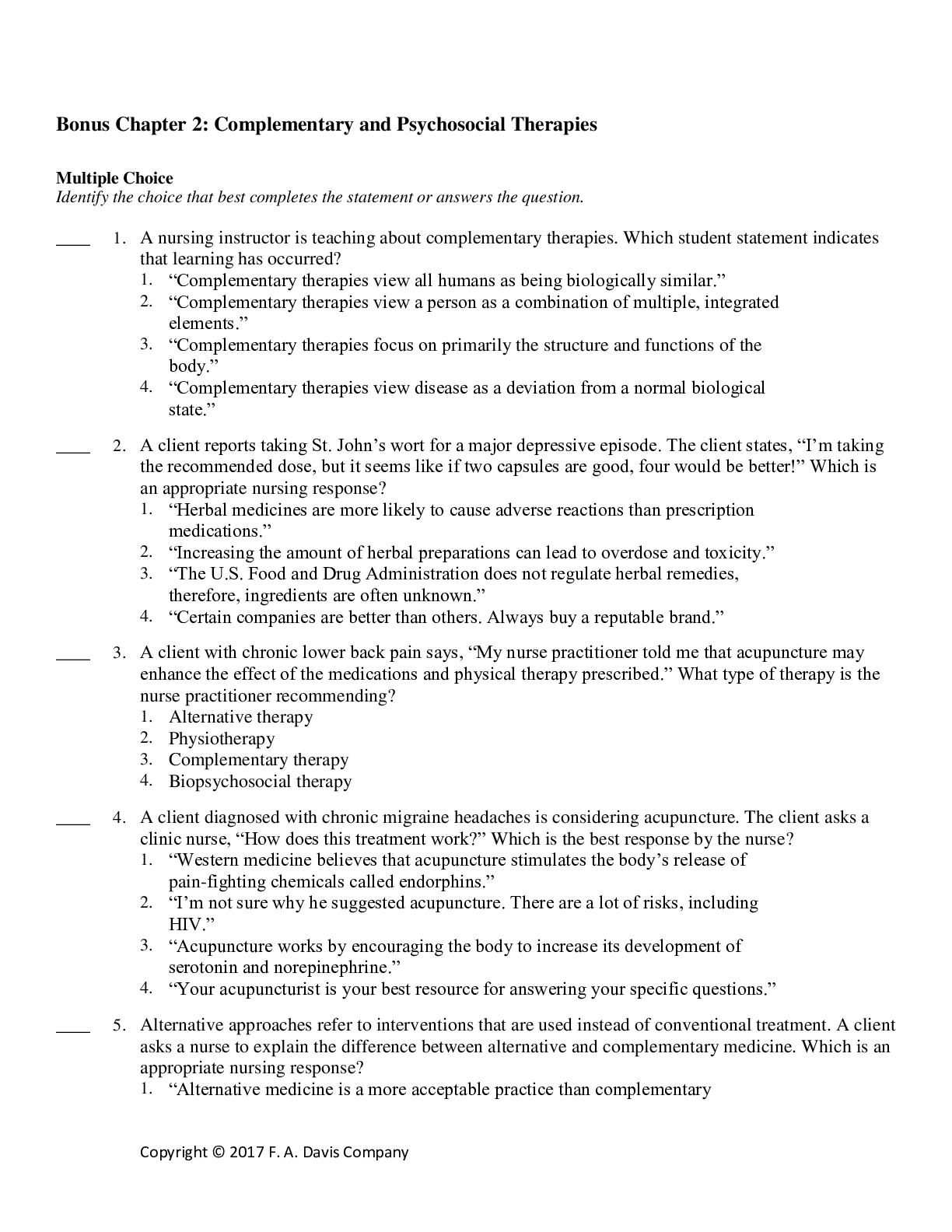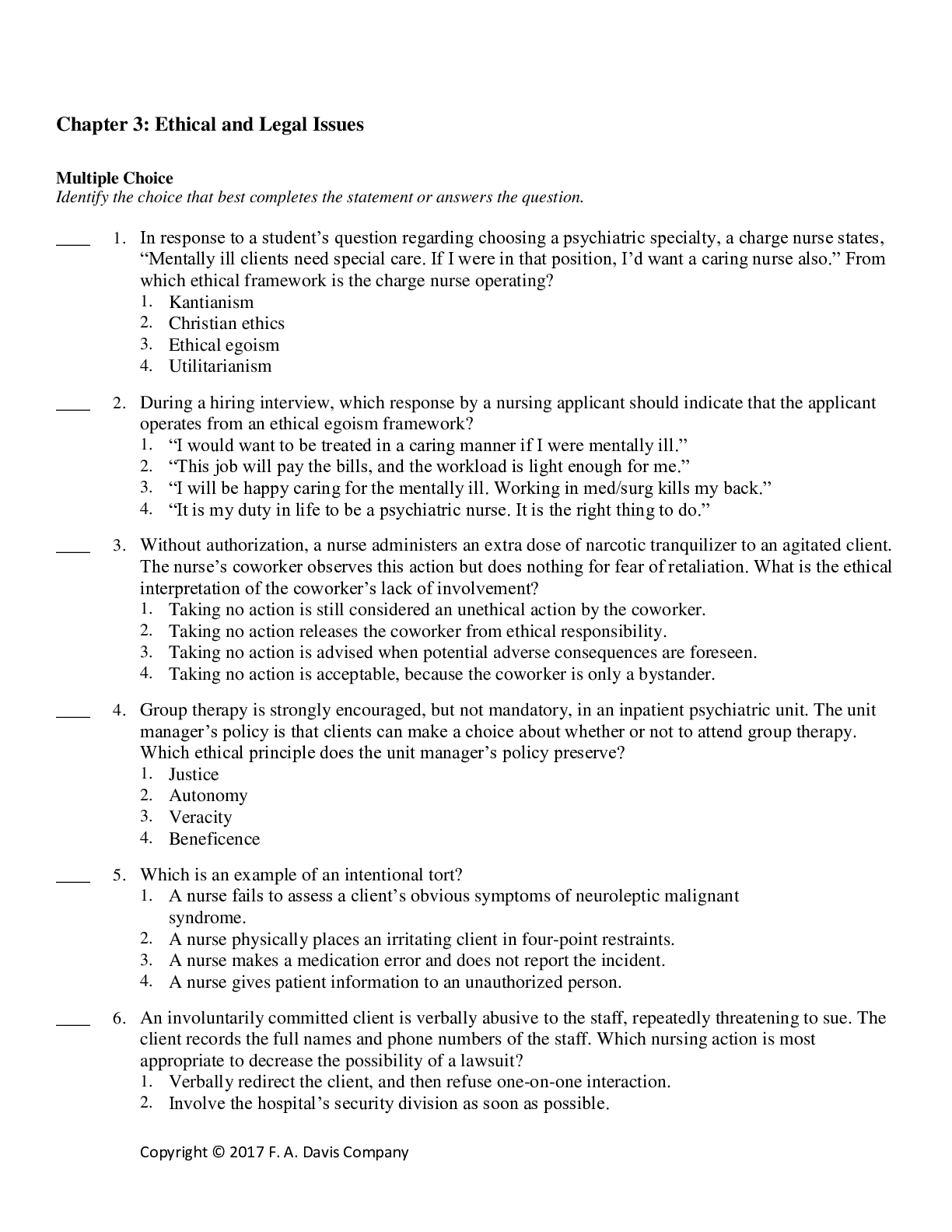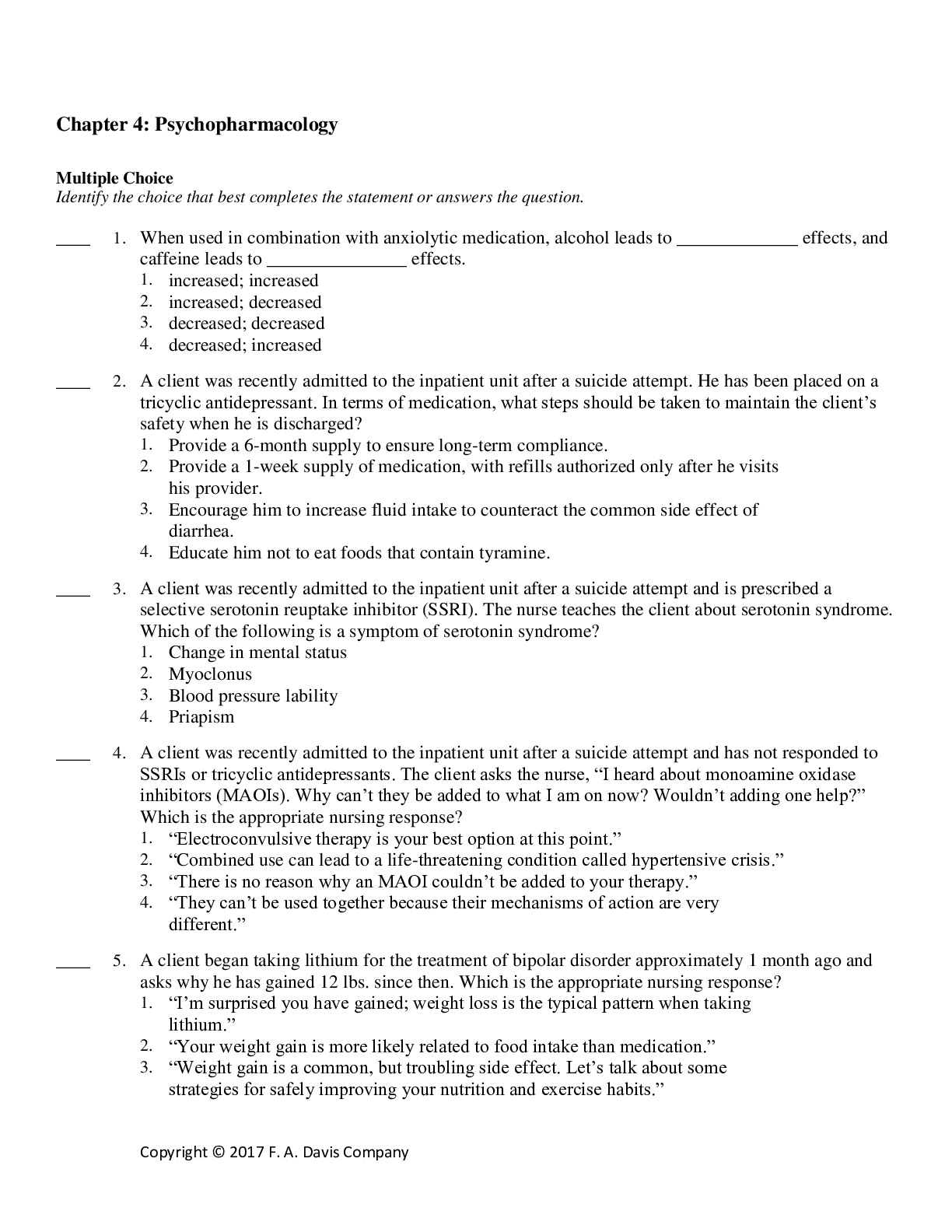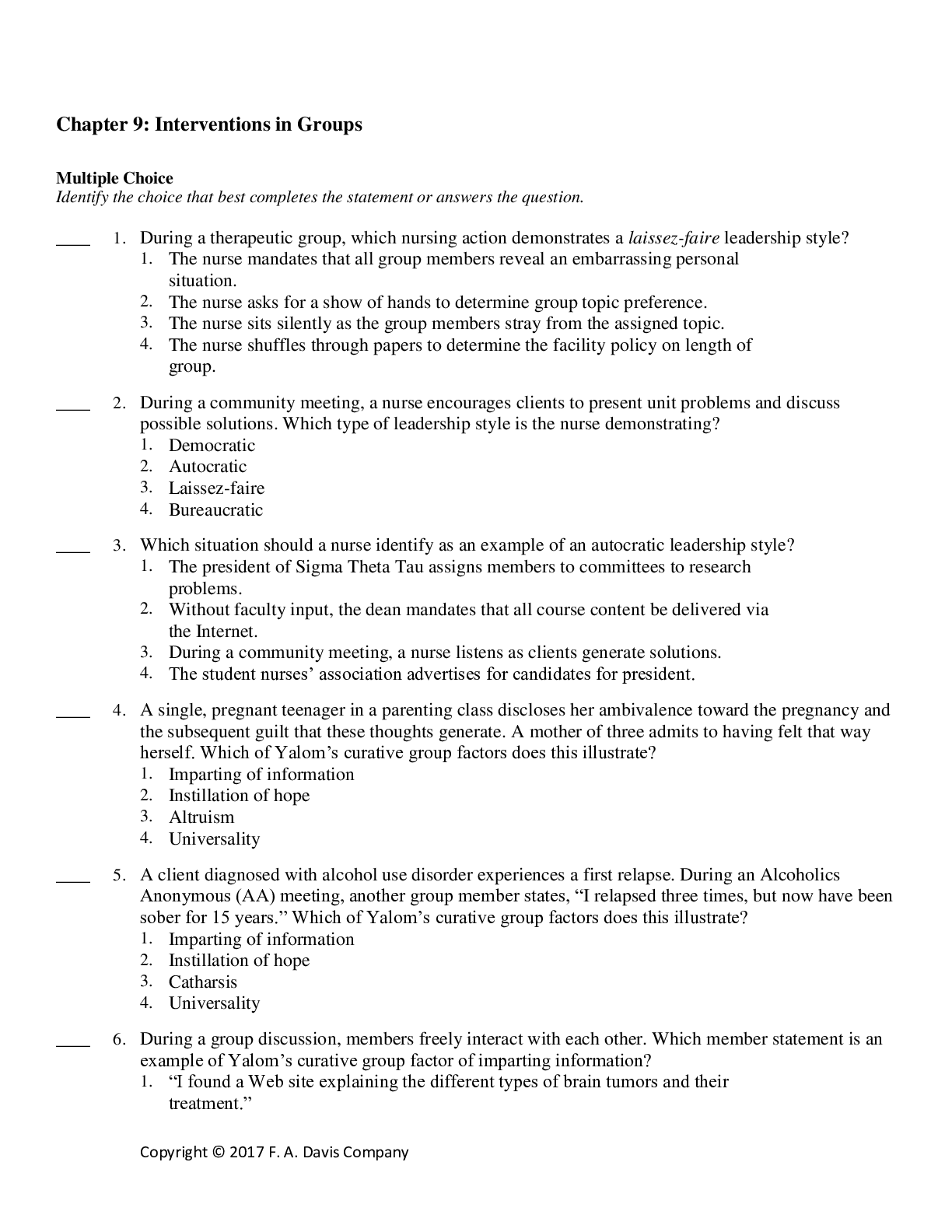*NURSING > QUESTIONS & ANSWERS > Chapter 11: The Recovery Model. With Answers Explained (All)
Chapter 11: The Recovery Model. With Answers Explained
Document Content and Description Below
Multiple Choice Identify the choice that best completes the statement or answers the question. ____ 1. A nursing instructor is teaching about recovery as it applies to mental illness. Which studen... t statement indicates that further teaching is needed? 1. “The goal of recovery is improved health and wellness.” 2. “The goal of recovery is expedient, comprehensive behavioral change.” 3. “The goal of recovery is the ability to live a self-directed life.” 4. “The goal of recovery is the ability to reach full potential.” ____ 2. Which situation presents an example of the basic concept of a recovery model? 1. The client’s family is encouraged to make decisions in order to facilitate discharge. 2. A social worker, discovering the client’s income, changes the client’s discharge placement. 3. A psychiatrist prescribes an antipsychotic drug based on observed symptoms. 4. A client diagnosed with schizophrenia schedules follow-up appointments and group therapy. ____ 3. A nursing instructor is teaching about the guiding principles of the recovery model, as described by SAMHSA. Which student statement indicates that further teaching is needed? 1. “Recovery occurs via many pathways.” 2. “Recovery emerges from strong religious affiliations.” 3. “Recovery is supported by peers and allies.” 4. “Recovery is culturally based and influenced.” ____ 4. A client diagnosed with alcohol abuse disorder is referred to a residential care facility after discharge. According to SAMHSA, which dimension of recovery is supporting this client? 1. Health 2. Home 3. Purpose 4. Community ____ 5. A client diagnosed with obsessive-compulsive disorder states, “I really think my future will improve because of my successful treatment choices. I’m going to make my life better.” Which guiding principle of recovery has assisted this client? 1. Recovery emerges from hope. 2. Recovery is person-driven. 3. Recovery occurs via many pathways. 4. Recovery is holistic. ____ 6. A nurse maintains a client’s confidentiality, addressed the client appropriately, and does not discriminate based on gender, age, race, or religion. Which guiding principle of recovery has this nurse employed? 1. Recovery is culturally based and influenced. 2. Recovery is based on respect. 3. Recovery involves individual, family, and community strengths and responsibility. 4. Recovery is person-driven. ____ 7. A nurse on an inpatient unit helps a client understand the significance of treatments, and provides the client with copies of all documents related to the plan of care. This nurse is employing which commitment in the “Tidal Model of Recovery?” 1. Know that Change Is Constant 2. Reveal Personal Wisdom 3. Be Transparent 4. Give the Gift of Time ____ 8. Which is the priority focus of recovery models? 1. Empowerment of the health-care team to bring their expertise to decision-making 2. Empowerment of the client to make decisions related to individual health care 3. Empowerment of the family system to provide supportive care 4. Empowerment of the physician to provide appropriate treatments ____ 9. A client experiences an exacerbation of psychiatric symptoms to the point of threatening self-harm. Which action step of the Wellness Recovery Action Plan (WRAP) model should be employed, and what action reflects this step? 1. Step 3: Triggers that cause distress or discomfort are listed. 2. Step 4: Signs indicating relapse are identified and plans for responding are developed. 3. Step 5: A specific plan to help with symptoms is formulated. 4. Step 6: Following client-designed plan, caregivers now become decision-makers. ____ 10. A nursing instructor is teaching about components present in the recovery process as described by Andresen and associates that led to the development of the Psychological Recovery Model. Which student statement indicates that further teaching is needed? 1. “A client has a better chance of recovery if he or she truly believes that recovery can occur.” 2. “If a client is willing to give the responsibility of treatment to the health-care team, they are likely to recover.” 3. “A client who has a positive sense of self and a positive identity is likely to recover.” 4. “A client has a better chance of recovery if he or she has purpose and meaning in life.” ____ 11. A client states, “My illness is so devastating, I feel like my life is on hold.” The nurse recognizes that this client is in which stage of the Psychological Recovery Model as described by Andersen and associates? 1. Moratorium 2. Awareness 3. Preparation 4. Rebuilding ____ 12. A client states, “I have come to the conclusion that this disease has not paralyzed me.” The nurse recognizes that this client is in which stage of the Psychological Recovery Model as described by Andresen and associates? 1. Moratorium 2. Awareness 3. Preparation 4. Rebuilding ____ 13. A psychiatrist who embraces the Psychological Recovery Model tells the nurse that a client is in the Growth stage. What should the nurse expect to find when assessing this client? 1. A client feeling confident about achieving goals in life. 2. A client who is aware of the need to set goals in life. 3. A client who has mobilized personal and external resources. 4. A client who begins to actively take control of his or her life. Multiple Response Identify one or more choices that best complete the statement or answer the question. ____ 14. Which of the following has SAMHSA described as major dimensions of support for a life of recovery? (Select all that apply) 1. Health 2. Community 3. Home 4. Religious affiliation 5. Purpose ____ 15. A nurse uses the commitments of the Tidal Model of Recovery in psychiatric nursing practice. Which of the following nursing actions reflect the use of the Develop Genuine Curiosity commitment? (Select all that apply.) 1. The nurse expresses interest in the client’s story. 2. The nurse asks for clarification of certain points. 3. The nurse encourages the client to speak his own words in his own unique way. 4. The nurse assists the client to unfold the story at his or her own rate. 5. The nurse provides the clients with copies of all documents relevant to care. Other 16. Order the six steps of The Wellness Recovery Action Plan (WRAP) Model as described by Copeland et al. ________ Daily Maintenance List ________ Things Are Breaking Down or Getting Worse ________ Crisis Planning ________ Develop a Wellness Toolbox ________ Early Warning Signs ________ Triggers Completion Complete each statement. 17. _________________________ from mental health disorders and substance use disorders is a process of change through which individuals improve their health and wellness, live a self-directed life, and strive to reach their full potential. [Show More]
Last updated: 1 year ago
Preview 1 out of 11 pages
Instant download

Buy this document to get the full access instantly
Instant Download Access after purchase
Add to cartInstant download
Reviews( 0 )
Document information
Connected school, study & course
About the document
Uploaded On
Jan 27, 2020
Number of pages
11
Written in
Additional information
This document has been written for:
Uploaded
Jan 27, 2020
Downloads
0
Views
109


























